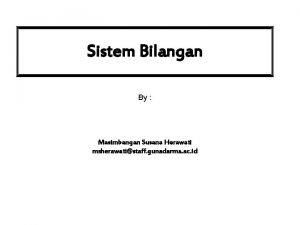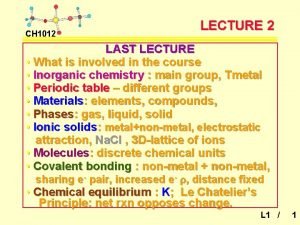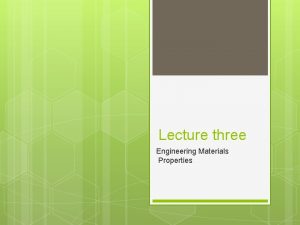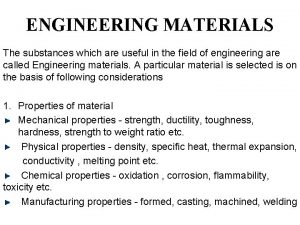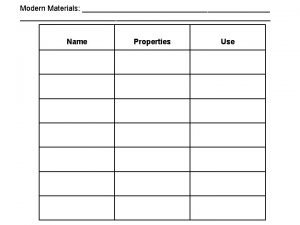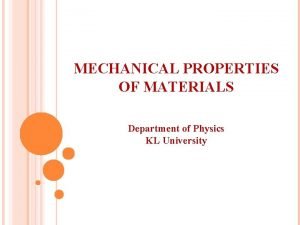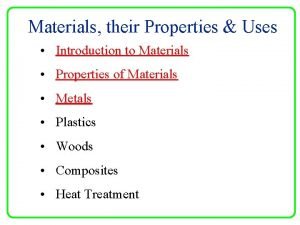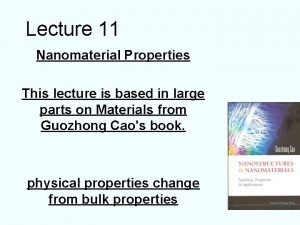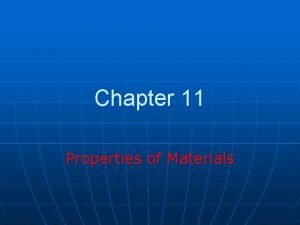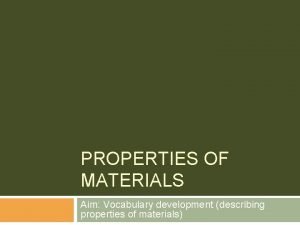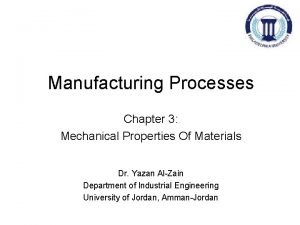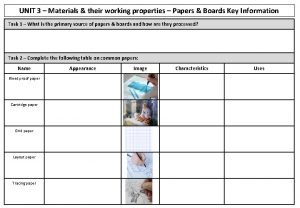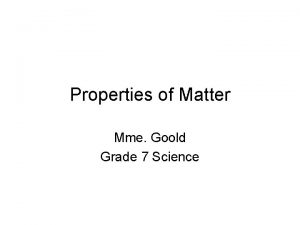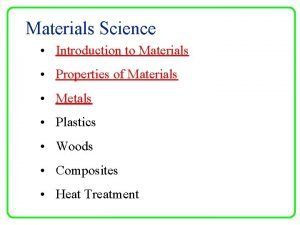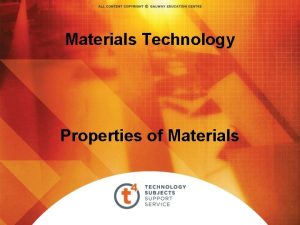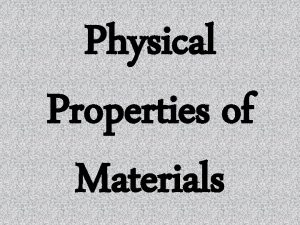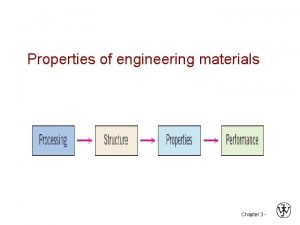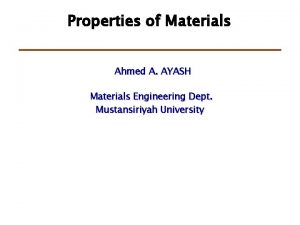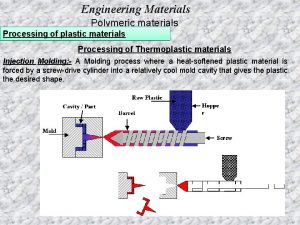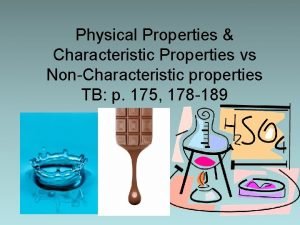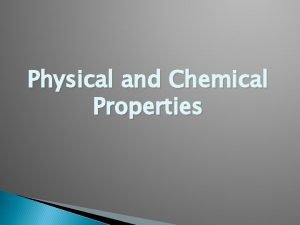1012 ENGINEERING MATERIALS ENGINEERING MATERIALS 1012 PROPERTIES OF

























- Slides: 25

1012 ENGINEERING MATERIALS

ENGINEERING MATERIALS (1012) PROPERTIES OF ENGINEERING MATERIALS Md. Tarikul Islam Junior Instructor, Environmental Technology Satkhira Polytechnic Institute 2

ENGINEERING MATERIALS (1012) Contents o Introduce the basic concepts associated with properties of materials. o Evaluate factors that affect the properties of materials. 3

ENGINEERING MATERIALS (1012) Engineering Material q Any material which has got application in engineering constructions is termed as engineering materials. q A Civil Engineer engaged in the task of planning, design and construction of building bridge, dams, roads, water purifications plants, sewage treatment plants or other structure, should be thoroughly familiar with the desire engineering materials and their properties. 4

ENGINEERING MATERIALS (1012) Properties of Materials q. A quality that defines a specific characteristic of a material is termed as a property. q. The properties of a material provide a basis for predicting its behavior under various conditions. Md. Mahfuzur Rahman, Assistant Lecturer, CE 5

ENGINEERING MATERIALS (1012) Objective of studying Properties of Engineering Material q. The requirements of materials for engineering applications are growing complex and there are more materials to choose from. q. The engineer must have more basic understanding of the behavior of materials because so many variations in properties are available. 6

ENGINEERING MATERIALS (1012) Objective of studying Properties of Engineering Material… q. The Engineer and the other related personnel must have to acquaint themselves thoroughly with the functions and qualities of engineering materials, because upon the quality of engineering materials, depends the quality of structures. q. To achieve maximum economy and to make the structure sufficiently strong and durable, the engineer must know the strength characteristics of the materials. 7

ENGINEERING MATERIALS (1012) Objective of Studying Properties of Engineering Material… q. To use the materials of the acceptable quality and strength to make a structure a harmonious blend of beauty, strength, utility and economy. 8

ENGINEERING MATERIALS (1012) Important Properties of Engineering Material Are: q. Physical Properties: Size, Shape, Density, Porosity, Structure. q. Mechanical Properties: Strength, Elasticity, Plasticity, Stiffness, Ductility, Malleability, Hardness, Brittleness, Resilience, Creep. q. Chemical Properties: Corrosion Resistance, Acidity, Alkalinity, Chemical Composition. 9

ENGINEERING MATERIALS (1012) Important Properties of Engineering Material Are: q. Thermal properties: Specific Heat, Thermal Expansion, Conductivity. q. Magnetic Properties: Permeability, Cohesive Force, Hysteresis. q. Electrical Properties: Conductivity, Dielectric Permittivity, Dielectric Strength. 10

ENGINEERING MATERIALS (1012) Standardization Most properties of the engineering materials must be evaluated entirely by experiment. Much of the standardization is done by the national organization set up in each country to improve the use of materials in engineering constructions. Some of These Organizations are: q BSI (British Standard Institute) q ASTM (American Society of Testing Materials) q AASHO (American Association of State Highway Official) q AASHTO (American Association of State Highway and Transportation Officials) q ACI (American Concrete Institute) 11

ENGINEERING MATERIALS (1012) The Following are the very Important Properties of Engineering Materials… Strength: It is the property of material that represents its ability to resist internal forces or stresses or loads without failure. Types of Loadings: Transverse Loading: Forces applied perpendicular to the longitudinal axis of a member. Transverse loading causes the member to bend and deflect from its original position, with internal tensile and compressive strains accompanying the change in curvature of the member. Transverse loading also induces shear forces that cause shear deformation of the material and increase the transverse deflection of the member. 12

ENGINEERING MATERIALS (1012) The Following are the very Important Properties of Engineering Materials… Types of Loadings: Axial Loading: The applied forces are collinear with the longitudinal axis of the member. The forces cause the member to either stretch or shorten. Torsional Loading: Twisting action caused by a pair of externally applied equal and oppositely directed force couples acting on parallel planes or by a single external couple applied to a member that has one end fixed against rotation. 13

ENGINEERING MATERIALS (1012) The Following are the very Important Properties of Engineering Materials… Stress: Stress is the intensity of internal force developed when an external force is applied on an engineering material surface. σ= P/A Where, σ = stress P=external force applied A= cross-sectional area of surface There are Three Types of Stresses: i. Compressive stresses ii. Tensile stresses iii. Shear stresses 14

ENGINEERING MATERIALS (1012) The Following are the very Important Properties of Engineering Materials… Strain: Strain is a measure of the deformation produced by the application of external force. Strain is denoted by the following expression: ε = x/L where ε is the strain, x is the extension or shortening of length and L is the original length. There are Three Types of Strain : i. Compressive strain ii. Tensile strain iii. Shear strain 15

ENGINEERING MATERIALS (1012) The Following are the very Important Properties of Engineering Materials… Elasticity: It is a property of a material which allows it to return to its original shape and size after the load to which it is subjected is released. Young's Modules of Elasticity: E= Stress/ Strain Modules of Rigidity: G= Shearing stress/ Shearing strain 16

ENGINEERING MATERIALS (1012) The Following are the very Important Properties of Engineering Materials… Bulk Modules: K= Direct stresses causing a change in volume/ Volumetric strain Poisson’s Ratio: Poisson's ratio is the ratio of transverse contraction strain to longitudinal extension strain in the direction of stretching force. Tensile deformation is considered positive and compressive deformation is considered negative. n = etrans / elongitudinal 17

CEN 213 CIVIL ENGINEERING MATERIALS The Following are the very Important Properties of Engineering Materials… Plasticity: Plasticity is the opposite property of elasticity. A perfectly plastic materials does not return to its original shape and size when the load causing deformation is remove. Malleability: Materials that can be hammered into thin sheets are malleable materials. 18

CEN 213 CIVIL ENGINEERING MATERIALS The Following are the very Important Properties of Engineering Materials… Brittleness: The opposite property of malleability is brittleness. Cast iron is an example of brittle materials. Ductility: Ductility indicates the ability of a material to deform in the plastic range without breaking. 19

ENGINEERING MATERIALS (1012) The Following are the very Important Properties of Engineering Materials… Fatigue: q. Certain materials are very often subjected to repeated stress. q. The term fatigue (fatigue strength) of a material is used to indicate its strength in resisting repeated stress. 20

CEN 213 CIVIL ENGINEERING MATERIALS The Following are the very Important Properties of Engineering Materials… Creep: q. In materials science, creep is the tendency of a solid material to move slowly or deform permanently under the influence of mechanical stresses. q. In many applications, engineering materials are required to sustain steady loads for long periods of time. 21

ENGINEERING MATERIALS (1012) The Following are the very Important Properties of Engineering Materials… Hardness: An appropriate definition of hardness is the resistance of a material to permanent deformation of its surface 22

ENGINEERING MATERIALS (1012) Factors Affecting Material Properties q. Temperature : Increasing temperature will decrease - Modulus of Elasticity - Yield Strength - Tensile Strength Decreasing temperature will: - Increase ductility - Reduce brittleness q Environment: Sulfites, Chlorine, Oxygen in water, Radiation 23

ENGINEERING MATERIALS (1012) Selection of Engineering Materials q. Selection of materials for engineering applications depends first upon their properties in relation to intended use. q. The next important considerations are economy and availability. Preference should always be given to the locally available materials. 24

25
 Uhmt 1012
Uhmt 1012 1012
1012 1012 angel
1012 angel Sistem bilangan desimal adalah
Sistem bilangan desimal adalah Ch 1012
Ch 1012 Optical properties of engineering materials
Optical properties of engineering materials Classification of engineering materials chart
Classification of engineering materials chart Extensive properties and intensive properties
Extensive properties and intensive properties Physical properties and chemical properties
Physical properties and chemical properties Physical properties of dental materials pdf
Physical properties of dental materials pdf Natural science matter and materials
Natural science matter and materials Modern materials textiles
Modern materials textiles Lateral strain
Lateral strain Stress strain curve toughness
Stress strain curve toughness Materials properties and uses
Materials properties and uses Hardness of nanomaterials
Hardness of nanomaterials Ideal requirements of dental cements
Ideal requirements of dental cements Properties of materials examples
Properties of materials examples Properties of materials vocabulary
Properties of materials vocabulary Manufacturing properties of materials
Manufacturing properties of materials Manufacturing properties of materials
Manufacturing properties of materials Materials and their working properties
Materials and their working properties Useful but harmful materials
Useful but harmful materials Classification of matter grade 7
Classification of matter grade 7 Metals and non metals grade 5
Metals and non metals grade 5 Properties of materials examples
Properties of materials examples



